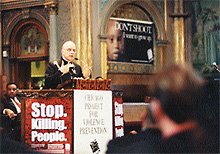|
|
|
|
|
|
|
 |
|
|
Cardinal George asks religious leaders to commit themselves to
programs to reduce gun violence in Chicago. Catholic New World / David V. Kamba |
|
Clergy needed to end violence
By Michael D. Wamble
STAFF WRITER
The linkage of faith-based organizations, churches and government
agencies has been a priority for the Chicago Project for Violence
Prevention since last September, when the project invited clergy
to enter into a “covenant” committing themselves to a specific
plan of action.
Over 130 members of the city’s clergy have signed on to the program
funded in part by the U. S. Department of Justice, Chicago Community
Trust and several other foundations.
Still, the group’s executive director, Gary Slutkin isn’t satisfied
with these results in his united crusade against prevention of
handgun assaults and deaths, a condition Slutkin labeled as “a
humanitarian emergency.”
On Feb. 15, Slutkin, Cardinal George and representatives of other
Christian denominations spoke to members of these three key groups
at New Mt. Pilgrim Missionary Baptist Church, to continue a collective
call for Chicago’s religious communities to take action against
outbreaks of violence in their neighborhoods.
The church is located in the West Garfield Park area of the city’s
11th District, where the project has fully implemented points
of attack against violence. To date, 15 fewer people have become
victims of gun violence.
Slutkin said he would like to gain additional resources to raise
the state of implementation in six other areas where the project
works up to the level of West Garfield Park.
According to project data, the rate of shootings has decreased
by 75 percent.
Cardinal George praised Slutkin for “re-imagining violence as
an epidemic in this country.”
So far, Chicago’s murder count is down by 23 persons in comparison
to February 2000.
“That is 23 less funerals, 23 less families to console, 23 more
people alive,” said the cardinal.
Project officials encouraged religious leaders to use churches
as “safe havens” by offering outreach programs as alternatives
to similar activities found in public parks, where gangs have
been known to draw up territorial boundaries.
“What would it take to open up a church?,” asked project leader
Norman Kerr. “Parks may be OK, but kids may not feel safe to go
to parks if they have to ‘catch a beat down’ to get there.”
The cardinal encouraged other religious leaders to move beyond
the walls of their houses of worship to touch the lives of those
in despair.
“We, as clergy, have to be at the heart of this matter. Imagine
what our city would be without violence or the fear of violence,”
he said, between two billboard-size posters.
The posters’ goals superimposed on faces of children were clear:
“I want to live” and “Don’t shoot! I want to grow up.”
To reach those goals, the cardinal said, clergy must join with
civic leaders and outreach workers based in specific communities
to build “a stronger, transforming coalition.”
Front Page | Digest | Cardinal | Interview
Classifieds | About Us | Write Us | Subscribe | Advertise
Archive | Catholic Sites | New World Publications | Católico | Directory | Site Map
|





